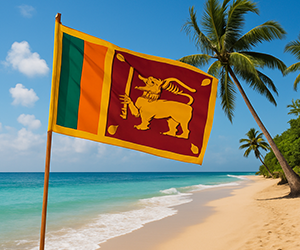Introduction
Rising in the heart of Sri Lanka, the Knuckles Mountain Range, locally known as “Dumbara Kanduvetiya” (the mist-laden mountain range), is a mystical, misty highland that beckons nature lovers, trekkers, and eco-tourists. Its unique name stems from the range’s resemblance to a clenched fist. This UNESCO World Heritage Site is not only visually stunning but ecologically vital, boasting a high degree of biodiversity and endemism.
Location and Geography
Located in the Kandy and Matale districts of central Sri Lanka, the Knuckles Mountains cover more than 21,000 hectares and reach elevations over 1,800 meters. The region bridges the dry and wet zones, creating diverse microclimates and ecosystems. The Mahaweli River, Sri Lanka’s longest, originates near this range.
Cultural and Historical Significance
For centuries, these mountains have played a significant role in local culture and folklore. They have served as retreats for monks, hiding places for rebels, and homes to villages preserving ancient Sinhalese customs. Local myths speak of enchanted caves and sacred peaks like Lakegala, said to be linked to the ancient King Ravana.
UNESCO World Heritage Status
In 2010, the Knuckles Conservation Forest was declared part of the Central Highlands World Heritage Site, recognizing its ecological and cultural value. The area is celebrated for its role in climate regulation, water conservation, and as a refuge for endangered species.
How to Get There
From Kandy, travelers can reach the Knuckles via Wattegama or Teldeniya in about two hours. Popular access points include Deanston, Riverston, Corbett’s Gap, and Meemure. From Colombo, expect a 5-6 hour journey. Public buses are available, but private transport or guided tours are more convenient.
Biodiversity and Ecology
Though small in size, the Knuckles support over 34% of Sri Lanka’s endemic trees and over 50% of its endemic vertebrates. The area features cloud forests, montane grasslands, and a range of wildlife habitats. Species include the purple-faced langur, Knuckles pygmy lizard, and countless rare orchids.
Best Time to Visit
The dry season from June to September is best for trekking, while January to March also offers clear, cool weather. Avoid the monsoon months (October to December) due to slippery trails and heavy rainfall.
Popular Hiking Trails
- Mini World’s End (via Deanston): Easy 3-4 km trail with stunning views.
- Duwili Ella Trail: A demanding 20 km hike ending at a cave waterfall.
- Knuckles Five Peaks: A challenging climb across five dramatic summits.
- Lakegala Trek (via Meemure): A mythical pyramid-shaped peak tied to ancient legends.
Flora and Fauna
The Knuckles are home to unique species:
- Endemic trees and shrubs
- Wild orchids and medicinal plants
- Mammals like leopards, civets, and sambar deer
- Birds such as junglefowl, eagle owls, and hornbills
Knuckles Forest Reserve
Managed by the Department of Forest Conservation, the reserve requires permits for certain treks and camping. The Deanston Conservation Center offers visitor information and trail guidance.
Waterfalls and Natural Wonders
The area features numerous waterfalls:
- Duwili Ella: Cave waterfall accessible through a forest trek
- Sera Ella and Bambarella Falls: Hidden gems ideal for swimming and photography
Village Experiences
Villages like Meemure, Loolwatte, and Thangappuwa offer homestays and eco-lodges where visitors can learn traditional farming, herbal medicine, and local cooking. These communities practice sustainable lifestyles deeply connected to nature.
Wildlife Spotting
The elusive Sri Lankan leopard, wild boars, pangolins, and an array of reptiles and birds inhabit this region. Guided treks improve your chances of spotting rare species.
Photography and Scenery
Knuckles is a paradise for landscape and wildlife photography. Misty mountain ridges, sunrise views, forest trails, and cascading waterfalls create the perfect canvas for stunning shots.
Sustainability and Conservation
Ecotourism is growing in the region. Regulations include bans on plastic, camping permits, and local guide requirements. Visitors are encouraged to follow Leave No Trace principles.
Travel Tips
- Hire a local guide for longer hikes
- Pack waterproof gear and sturdy boots
- Bring cash and essentials, as amenities are limited
- Avoid solo trekking in remote areas
Packing Essentials
- Water, snacks, and reusable containers
- Rain gear and sun protection
- First-aid kit and flashlight
- Maps or GPS device (limited cell coverage)
Nearby Attractions
While exploring the Knuckles, consider visiting:
- Meemure Village
- Ritigala Forest Monastery
- Victoria Reservoir and Dam
- Hunnasgiriya Tea Plantations
FAQs
Do I need a permit to hike in Knuckles? Yes, especially for camping or trekking in protected zones.
Is it safe for solo travelers? Generally yes, but it’s safer to go with a guide or group.
Are there hotels in the Knuckles Range? No major hotels, but eco-lodges, campsites, and homestays are available.
Final Thoughts
The Knuckles Mountains offer a rare blend of adventure, natural beauty, and cultural immersion. Far from the usual tourist trail, this highland paradise invites you to explore Sri Lanka’s wild heart through mist-covered peaks, forested valleys, and warm village hospitality. Whether you’re an experienced trekker or a mindful traveler, the Knuckles will leave a lasting impression and a deep appreciation for the island’s untamed spirit.




